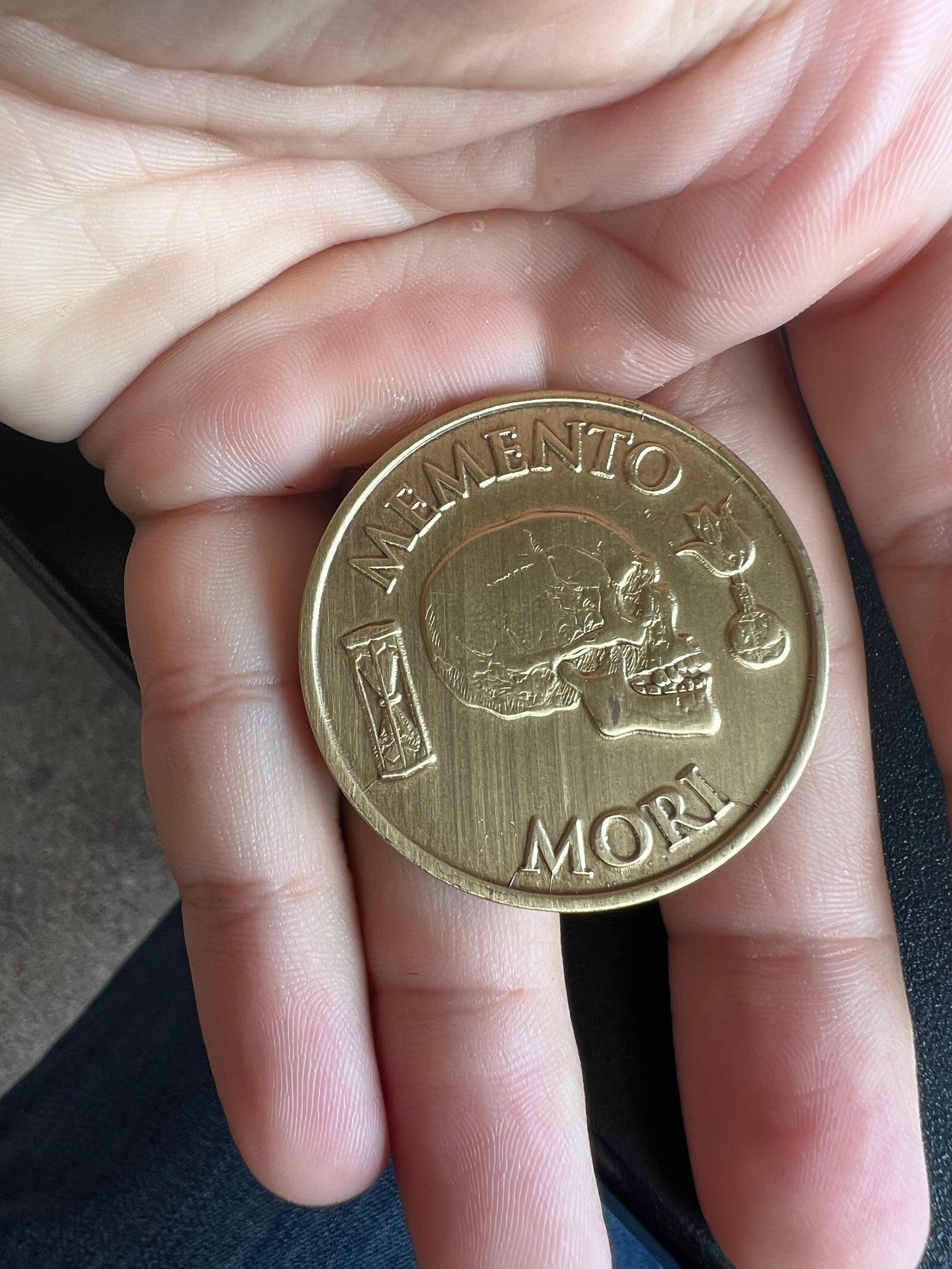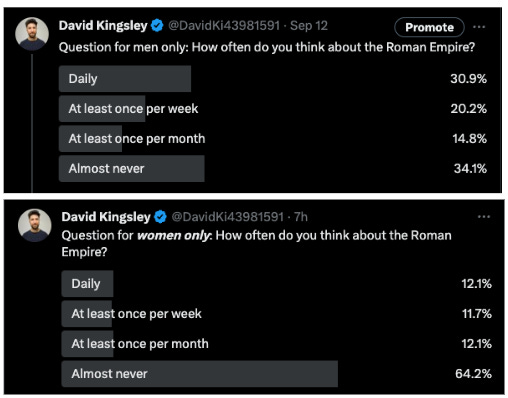How often do you think about the Roman Empire?
Analysis of Men vs Women

Introduction:
A few days ago, an obscure question made the rounds in my texting group chat: “how often do you think about the Roman Empire?” It led to an interesting discussion since all the men seemed to think about the Roman Empire with fair regularity, and the women didn’t seem to think about it at all. The disparity in responses by gender piqued my interest, and I began to ask the question anecdotally to friends. During one such encounter last week, I asked this question to a male colleague of mine during lunch, and without hesitation, he pulled out a Roman coin from his pocket (Figure 1)

Interestingly, this isn't just idle chatter; it's a trend that's been going viral on social media (Figure 2). Anecdotally, it seems that men, myself included, have a proclivity to daydream about the Roman Empire far more than women. There are many aspects of this that are interesting, why does anyone spend time thinking about the Roman Empire? Is it its historical importance, feelings of societal collapse, or age transcending tropes like ‘memento mori’? Regardless, I found this curious, particularly whether there is truly a gender divide. To answer this question, I conducted a mini-survey using the polling feature of X (formally Twitter).
The Survey:
I rolled out a poll on Twitter, posing the question: 'How often do you think about the Roman Empire?' To get a nuanced view, I created two separate polls—one targeted at men and the other at women. This approach allowed for a direct comparison between the responses from each gender. To zero in on my target audience, I used a promotional feature that enabled me to direct the poll based on the user's self-identified gender. Each poll garnered over 200 responses, making for a robust data set to analyze (Figure 3)
Survey Results:
I began by creating a contingency table that summarized the survey results (Table 1).
Data Visualization:
Next, I crunched the numbers and whipped up a bar chart to bring the data to life (Figure 4). At first glance, men seem to have a more frequent rendezvous with thoughts of the Roman Empire—daily, weekly, and monthly—compared to women. The most eye-catching stat? A whopping 35% of male respondents think about the Roman Empire every single day! On the flip side, the 'Almost never' camp is predominantly female, making up nearly 70% of the responses from women. While this paints a vivid picture, these are only initial observations. To make bolder statements, we'll need to dive into a more rigorous statistical analysis to see what's really going on.

Statistical Analysis Summary:
Here is how I assessed the data. A more detailed account of this can be found at the end for those interested.
Initial Summary: I started by summarizing the survey results, providing an overview of the responses from men and women regarding how frequently they think about the Roman Empire.
Chi-Square Test for Independence: I performed a Chi-Square test that revealed a statistically significant association between gender and the frequency of thinking about the Roman Empire.
Effect Size (Cramér's V): I calculated the effect size using Cramér's V, which indicated a moderate association between the two variables.
Discussion and Conclusion:
The data reveals a fascinating divergence in how often men and women think about the Roman Empire. While the reasons for this discrepancy are beyond the scope of this survey, they open a window to a myriad of questions worth exploring. Could this be a manifestation of how different genders engage with history or perhaps an insight into what topics occupy our idle thoughts? The moderate association, as indicated by the Cramér's V value, suggests that this isn't a trivial difference but a noticeable trend that could be studied further.
It would be fascinating to delve deeper and explore what underlying factors contribute to this disparity. Is it a result of differing educational backgrounds, interests, or something more complex? Further research, perhaps incorporating more variables such as age, educational level, or interest in history, could provide more nuanced insights. An additional variable that may be interesting is how this survey results are effected temporally, e.g., are people thinking more about the Roman Empire than they use to?
Of course, every study has its limitations, and this one is no exception. The self-selecting nature of Twitter polls and the lack of additional demographic data do place some boundaries on the conclusions. Yet, within these limitations, the survey serves as an interesting starting place for discussions about our gender-specific daydreams.
How you can support this Substack
These newsletters take a significant amount of effort to put together and are totally for the benefit of the reader. If you find these explorations valuable, there are multiple ways to show your support:
Engage: Like or comment on posts to join the conversation.
Subscribe: Never miss an update by subscribing to the Substack.
Share: Help spread the word by sharing posts with friends directly or on social media.
Statistical Analysis Details (for those interested):
Chi-Square Test for Independence: To determine if the observed differences in the frequencies are statistically significant. This test is used for comparing categorical data (like the survey).
The null hypothesis (H0) for the test states that the two categorical variables (gender and response frequency) are independent, meaning there is no association between them. The alternative hypothesis (Ha) suggests that there is an association between the two variables.
Chi-squared value: 48.20
p-value: 1.93 x 10^-10
Degrees of freedom: 3
Expected frequencies: the table of expected frequencies is generated under the assumption that the null hypothesis is true.
The p-value of 1.93 x 10^-10 is far less than the commonly used significant level of 0.05. This suggests we can reject our null hypothesis. Therefore, we can conclude that there is a statistically significant association between gender and the frequency with which the individuals think about the Roman Empire.
Effect size (Cramér's V): To understand the strength of the association, I calculated the effect size.
v = 0: no association between variables
0 < V < 0.3: weak association
0.3 < V < 0.5: moderate association
V > 0.5: strong association
The Cramér's V value was approximately 0.317, indicating a moderate association between gender and frequency of thoughts about the Roman Empire.
Post-hoc pairwise comparisons: To determine the differences between specific groups, pairwise comparisons can be made between categories to determine which specific categories contribute to the observed Chi-Square value. The results of the post-hoc analysis indicate that all the pairwise comparisons between the categories within each gender are significant at the Bonferroni-corrected alpha level of 0.005. This means that each specific frequency category ("Daily," "At least once per week," "At least once per month," "Almost never") significantly contributes to the overall difference between men and women in how often they think about the Roman Empire.





Fascinating question. I have to admit, I never think about the Roman Empire unless it's in relation to Monty Python's Life of Brian. Reading your article, I paused and thought, about how our daydreaming is formed and influenced by various factors and which of those factors are inherently dependent on gender to various degrees, if any. Root cause analysis, if you will.
From your results we get a moderate association, would that indicate that with a larger sample size V would increase? You could add a poll here, too, and leave it open. I guess, me not thinking about the Romans makes me an outlier.
Rome has biblical significance in ways very few places have. The world being predominately Christian and the history of the location pretty much means, so many things on a daily basis can be tied back to Rome in some way. Hell, their invention of aqueducts paved way for massive expansion of civilization. Both architecturally and engineering wise, we wouldn't be what we are today without the Romans.